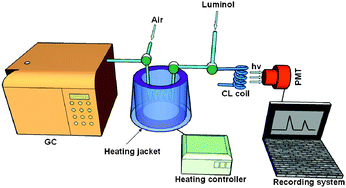In the present work, a novel thermal catalysis induced chemiluminescence (TC-CL) technique was developed for selective determination of volatile chlorinated hydrocarbons (VCHs). Thermal catalysis of volatile chlorinated hydrocarbons on the surface of a polytetrafluoroethene (PTFE) tube at the temperature of 210 °C has been easily carried out, and the products of catalytic oxidization can arouse intensive chemiluminescence emission in a luminol solution. By coupling with gas chromatography, a simple methodology has been developed for simultaneous detection of chlorinated hydrocarbons including tetrachloromethane, chloroform, dichloromethane and 1,2-dichloroethane. Under optimized conditions, the linear range of tetrachloromethane is 0.103–10.4 μmol with a limit of detection (LOD) of 0.034 μmol, and the relative standard deviation (RSD) of 4.15 μmol tetrachloromethane is less than 5% (n = 6). This novel methodology features the advantages of simple construction, rapid analysis, long life-time and high selectivity for chlorinated hydrocarbon detection.

You have access to this article
 Please wait while we load your content...
Something went wrong. Try again?
Please wait while we load your content...
Something went wrong. Try again?


 Please wait while we load your content...
Please wait while we load your content...